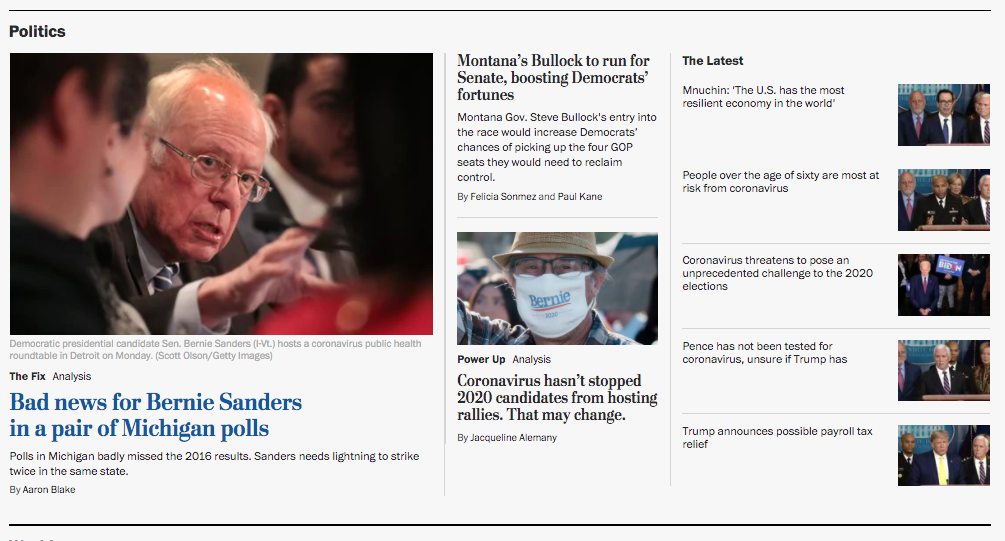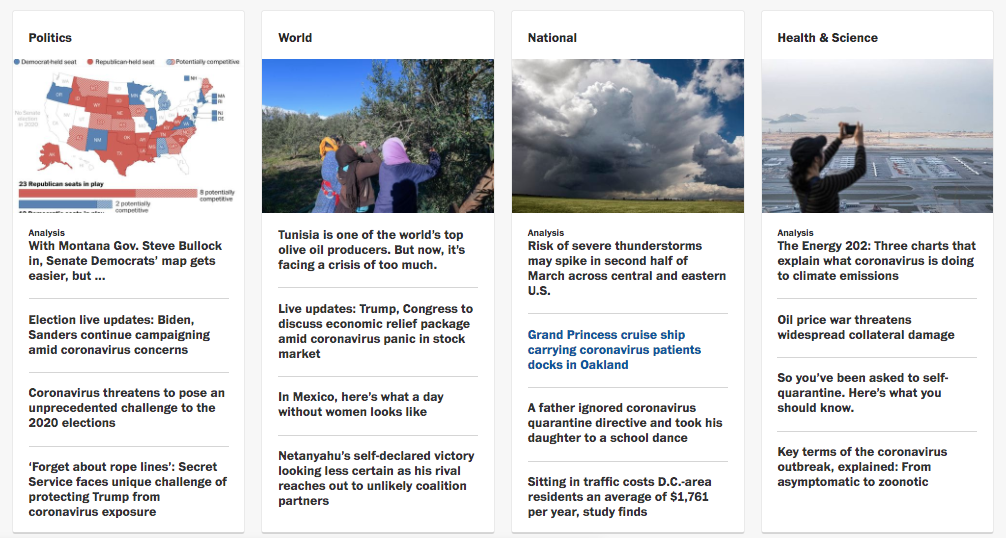How The Washington Post’s homepage redesign is designed to fight subscriber churn

The Washington Post knows that people who visit its site homepage are more likely to become subscribers, and that subscribers who visit the homepage are less likely to churn, so it overhauled the homepage in an attempt to lure more readers to it.
On Mar. 9, the Post began testing a new design for its homepage that shows off more kinds of the paper’s content. Instead of lists of articles published in different sections of the site, each section now gets its own bucket of stories selected by editors. The design, which will be visible to 20% of the Post’s national audience at first, is also meant to foreground the Post’s stable of opinion writers, a direct response to reader feedback that the paper’s product team has been gathering.
The homepage redesign is also the first piece of a multistep redesign that will ultimately include the Post’s newsletters, article page templates and mobile app. The redesign will not affect the height of the Post’s paywall, though it will replace the programmatic display unit currently slotted at the top of the homepage with a direct-sold unit. It is also designed to help the page load faster.
“The No. 1 biggest thing we’re learning in our user research is that people are just really overwhelmed by the amount of information that’s out there,” said Kat Downs Mulder, the Post’s vp of product. “It’s about making sure the journalism we produce is easy to consume.”


Downs Mulder said the Post plans to roll out additional changes to the homepage every few weeks, and the product team will rely on both qualitative and quantitative feedback to assess audience response. Two of the quantitative metrics the Post will watch most closely is number of homepage visits, as well as how much time elapses between visits to the homepage.
Ad position: web_incontent_pos1
A majority of the people who will see these changes will be Post subscribers, in part because most of the Post’s homepage audience is subscribers, Downs Mulder said. Though she declined to share specific numbers, Downs Mulder said a large number of subscribers visit the homepage regularly, and those who do are less likely to churn.
Along with The New York Times and The Wall Street Journal, the Washington Post has been one of the winners of the news media’s pivot to consumer revenue. In December 2018 it announced that it has 1.5 million digital subscribers.
The rise of search and social distribution over the past decade forced many news organizations to rethink the value of their homepages, particularly as audience scale became a top priority. But more recently, as news publishers have started to focus on building direct connections to their readers and driving subscriptions, the homepage has started to become more important again. In the Post’s case, one of the top priorities for the redesign is exposing Post readers to a wider variety of the content the paper publishes.
“It’s the best page where you can merchandise your content and your value proposition,” said Dan Gardner, the CEO of Code & Theory, said of a news site’s homepage. “The homepage is probably still the most-viewed individual page in any given month [for a typical news website].”
Those dual roles mean a continued focus on human curation. While some of the contents of the Post’s homepage will be delivered automatically – later this year, the Post will test additional personalization features, including one which will allow infrequent visitors of the site to catch up on major stories – the new modules that appear on the Post’s homepage will be chosen by editors.
Ad position: web_incontent_pos2
“Most of our users get what our editors think is most important,” Downs Mulder said. “It’s also about how we position them in the narrative of whatever stories are unfolding.”
More in Media

NewFronts Briefing: Samsung, Condé Nast, Roku focus presentations on new ad formats and category-specific inventory
Day two of IAB’s NewFronts featured presentations from Samsung, Condé Nast and Roku, highlighting new partnerships, ad formats and inventory, as well as new AI capabilities.

The Athletic to raise ad prices as it paces to hit 3 million newsletter subscribers
The New York Times’ sports site The Athletic is about to hit 3 million total newsletter subscribers. It plans to raise ad prices as as a result of this nearly 20% year over year increase.

NewFronts Briefing: Google, Vizio and news publishers pitch marketers with new ad offerings and range of content categories
Day one of the 2024 IAB NewFronts featured presentations from Google and Vizio, as well as a spotlight on news publishers.
Ad position: web_bfu